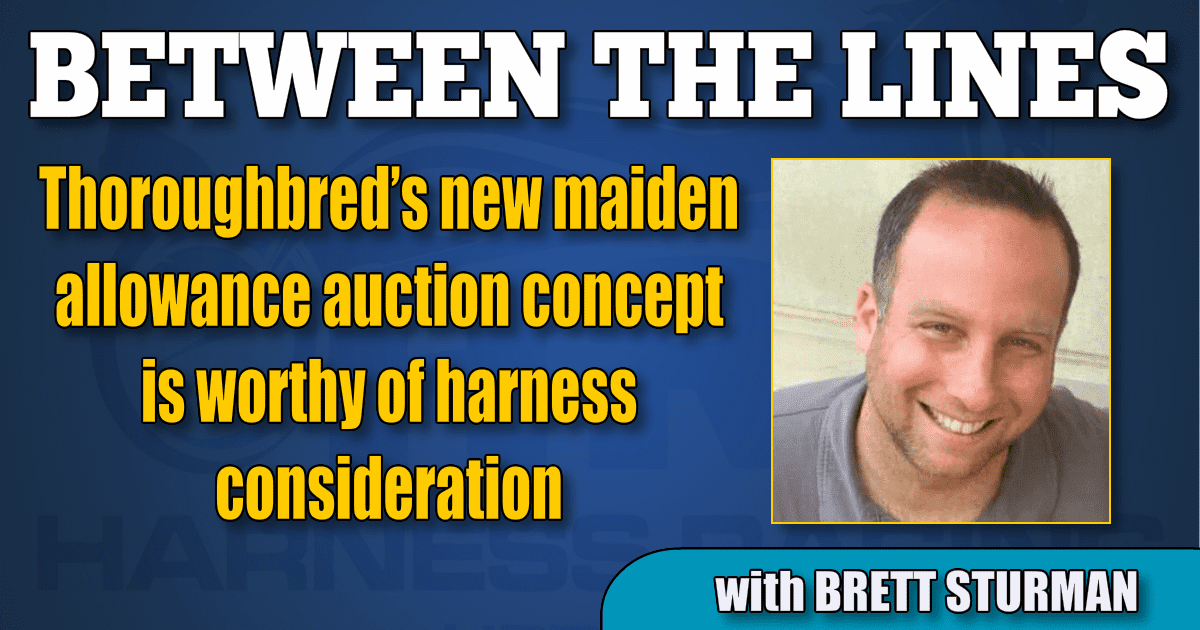Thoroughbred’s new maiden allowance auction concept is worthy of harness consideration
by Brett Sturman
I often see chatter amongst harness racing circles on ways that harness racing can emulate some of the successful workings from their thoroughbred counterparts. I usually don’t see many of these ideas as viable with the most recent being harness racing’s attempt to mirror the Pegasus World Cup by having owners of 2-year-olds ante up $100,000 each to race for $1 million (an idea that’s been since put on hold), but out of New York this week comes an idea that absolutely warrants harness racing consideration.
This week in the thoroughbred industry, the New York Racing Association (NYRA) announced a series of maiden races to be conducted at this summer’s famed Saratoga meet for purses of $75,000 that are to be restricted to only 2-year-olds that were purchased at sale for $45,000 or less. The overarching logic for it is that smaller-to-middle market horses can be competitive, and in the process give owners a chance to realize early returns on their investments in young horses. Similar as to the expected thoroughbred benefits to owners, sales companies and breeders, such an initiative could be a boon for those across harness racing as well. So, how specifically then could this play out in our industry?
One of the more hotly contested debates has been where to direct purse money. For example, should more money be diverted away from older claimers and put into maiden races as a way to incentive owners to buy young horses. Taking this scenario a step further, what you could have is increased maiden purses and then within that, have races that are restricted to those who were purchased at their most recent sale for under let’s say $15,000.
Unlike thoroughbreds, 2-year-old maiden claiming races in harness racing are non-existent. What happens often then is that especially early in the 2-year-old season, there is little distinction in a 2-year-old maiden race and a stakes race. All the time there are horses that come out of these 2-year-old maiden races and are immediately successful stakes types, and vice-versa where quality horses drop from being competitive in top level sire stakes races after pacing in 1:51 into a maiden (or a n/w 2 that’s filled with maidens). In this situation, if you have moderately quality horse that can only pace in about 1:55 it can be difficult to compete – even in maiden races.
Putting a restriction on the maiden or n/w 2 race based on sale price can be a way to give horses from mid-priced stallions a chance to race early in their careers against horses not from the most expensive sires. As an example specific to New York, you could have a trotter from new stallions Devious Man or Met’s Hall and be able to race them in NY without having to go up against a $100,000 horse by Chapter Seven. Of course, you’d have to race against whoever is entered once you get into the various sire stakes levels, but at a minimum it gives lower-priced horses a chance to get their careers off to decent starts while getting owners early returns on their investments. It gives the smaller owners a chance to compete before having to race against the typical powerhouse stables that seem to have the market cornered.
The benefits to gaining new owners and to sales companies are obvious. Smaller owners in particular have been hesitant in recent years to buy yearlings or 2-year-olds because of what they’re up against. It’s tough to compete in stakes races at 2 and 3 when an overwhelming majority of the races are won by a select number of trainers. It’s even more tough when you know you’ll be taking your $10,000 So Surreal against a $150,000 Captaintreacherous. Giving these owners the ability to race against horses that were purchased on comparable budgets could certainly help cultivate new ownership.
From a sales standpoint, these lower-mid priced horses now have more value than they would have had otherwise. With more of an interest now in these horses and with more potential owners bidding, these horses would sell for more than they would today. The difference would be seen at all the major sales including Harrisburg and Lexington, but where you’d really see the impact are at sales like Goshen, Morrisville, Ohio and Hoosier where most of the horses will fall into the lower to mid-range price categories.
To make things even more interesting, using the recent sale price as a race condition could be extended to beyond maidens. For years, one of the key reasons to buy a 2-year-old from the Harrisburg sale was to buy with the intent to race them in upcoming winter series racing at the Meadowlands in non-winners conditions. A lot of these 2-year-olds are unproven, and it would only help spur interest in these types at the sales if knew that not only could you race them in an upcoming series against younger horses, but that you could race them in a series that restricted to ones that were purchased for under a nominal amount. This way you could safely avoid the horse that’s still a maiden but has been timed in 1:50.4 from the Red Mile. Doing so would again increase sales, but also lead to more races being filled and more horses out on the track.
To be clear, harness racing already does provide ample opportunities for young horses to make money. Sticking still with New York, there are a myriad of different sire stakes levels and in some of them you don’t have to trot quicker than 2:00 at Yonkers as a 2-year-old to make money. The same can be said for sire stake programs in other states. But providing owners with further incentives to be active and to be involved with horses that otherwise might be overlooked seems like an all-around win for the industry.
















